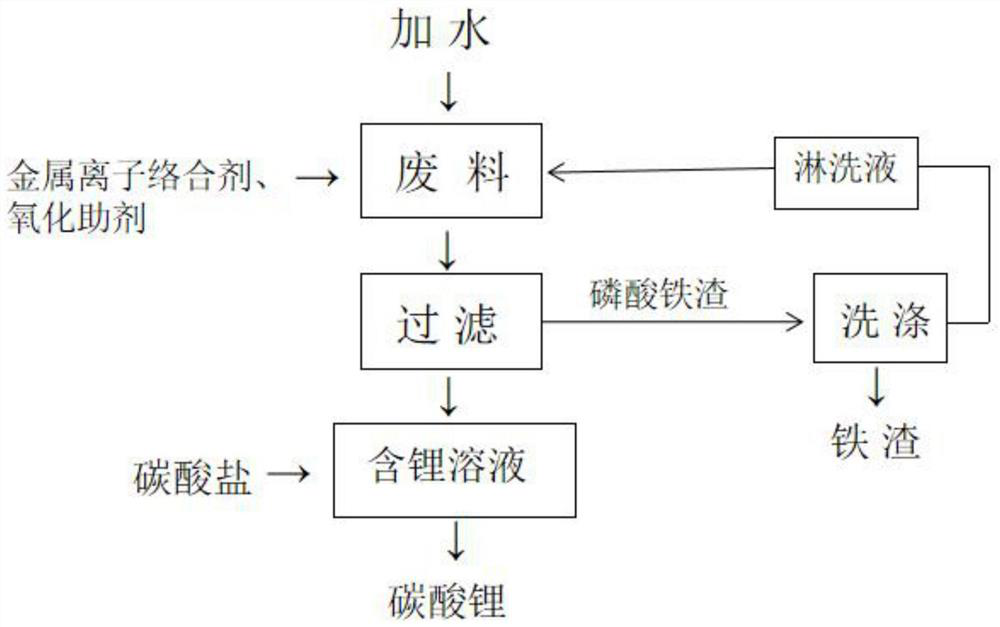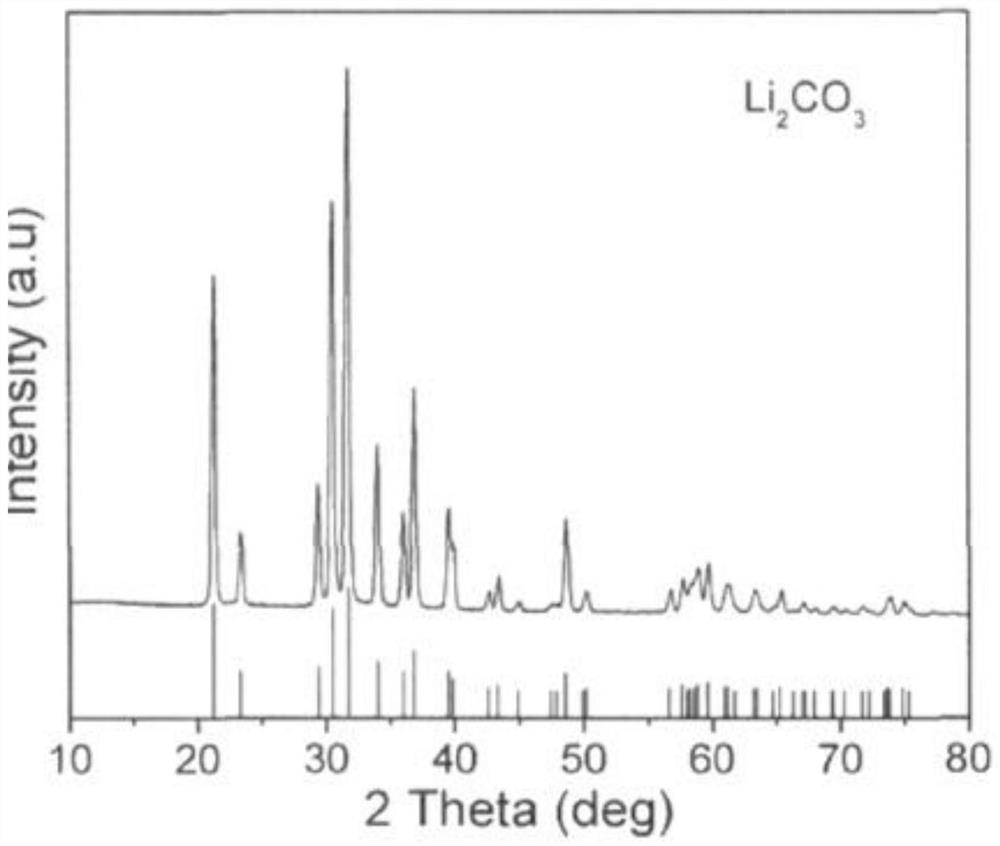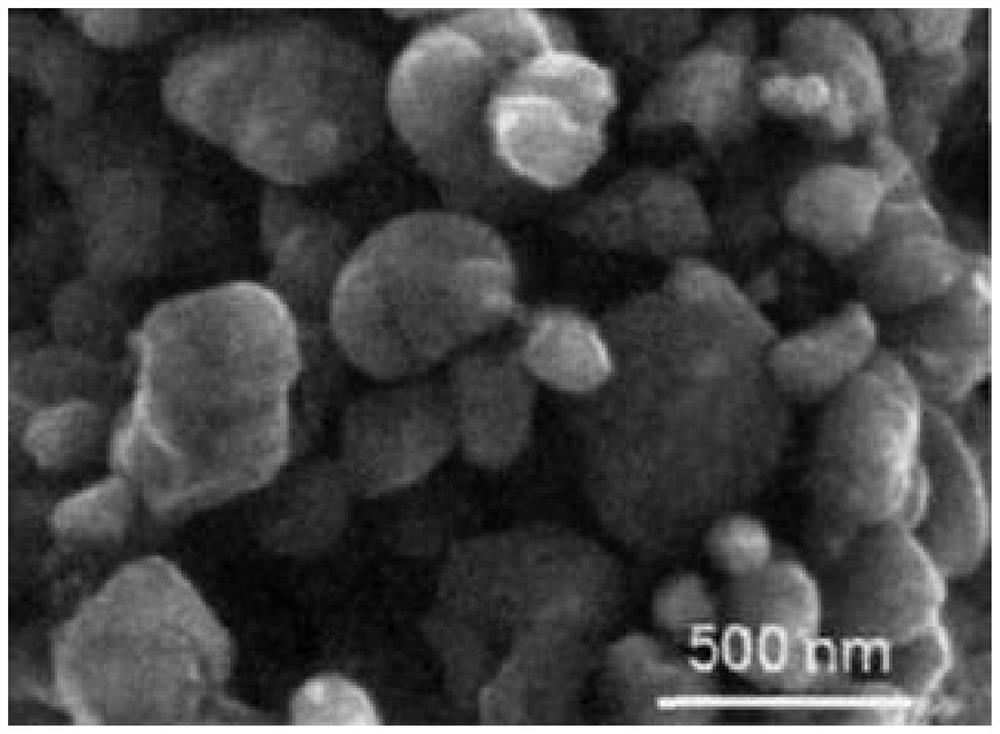Method for recycling lithium in waste lithium iron phosphate battery through acid-free extraction
A technology of lithium iron phosphate battery and lithium iron phosphate, which is applied in the direction of recycling by waste collectors, can solve the problems of waste of resources and other problems, and achieve the effects of avoiding waste, short reaction time, and accelerated leaching speed
- Summary
- Abstract
- Description
- Claims
- Application Information
AI Technical Summary
Problems solved by technology
Method used
Image
Examples
Embodiment 1
[0040] A method for recovering lithium in waste and old lithium iron phosphate batteries by acid-free leaching, comprising the following steps:
[0041] 1) Mix 100g of waste lithium iron phosphate cathode material with a mass fraction of 92% and 300mL of water to make a slurry;
[0042] 2) 3g FeCl 3 , 5.8g of ammonium citrate was added to the slurry in step 1), the temperature of the system was heated to 70°C, and the reaction was filtered for 2 hours to obtain a lithium-containing solution (99.5wt%) and iron phosphate slag;
[0043] 3) rinsing the iron phosphate slag obtained in step 2) with water, and returning the eluent to step 1) for pulping;
[0044] 4) 80g of sodium carbonate and 60mL of lithium-containing solution are mixed and reacted to obtain a lithium carbonate product, the purity of the lithium carbonate product is 98%, the yield is 99.8%, and the selectivity of lithium is 99.5%.
Embodiment 2
[0046] A method for recovering lithium in waste and old lithium iron phosphate batteries by acid-free leaching, comprising the following steps:
[0047] 1) Mix 100 g of waste lithium iron phosphate cathode material with a mass fraction of 92% and 200 mL of water to make a slurry;
[0048] 2) Put 4g of Fe 2 (SO) 4 , 4.8 g of sodium citrate was added to the slurry in step 1), the temperature of the system was heated to 75 ° C, and filtered after 2 h of reaction to obtain a lithium-containing solution (99.0 wt%) and iron phosphate slag;
[0049] 3) rinsing the iron phosphate slag obtained in step 2) with water, and returning the eluent to step 1) for pulping;
[0050] 4) 80 g of potassium carbonate and 60 mL of lithium-containing solution are mixed and reacted to obtain a lithium carbonate product, the purity of the lithium carbonate product is 96.6%, the yield is 99.7%, and the selectivity of lithium is 99.0%.
Embodiment 3
[0052] A method for recovering lithium in waste and old lithium iron phosphate batteries by acid-free leaching, comprising the following steps:
[0053] 1) Mix 100 g of waste lithium iron phosphate cathode material with a mass fraction of 93.1% and 500 mL of water to make a slurry;
[0054] 2) Put 2g of Fe(NO 3 ) 3 , 3 g of potassium iodide was added to the slurry in step 1), the temperature of the system was heated to 80 ° C, and the reaction was filtered after 2 h to obtain a lithium-containing solution (99.5 wt %) and iron phosphate slag;
[0055] 3) rinsing the iron phosphate slag obtained in step 2) with water, and returning the eluent to step 1) for pulping;
[0056] 4) 70 g of potassium carbonate and 60 mL of lithium-containing solution are mixed and reacted to obtain a lithium carbonate product, the purity of the lithium carbonate product is 97.8%, the yield is 99.8%, and the selectivity of lithium is 99.5%.
PUM
 Login to View More
Login to View More Abstract
Description
Claims
Application Information
 Login to View More
Login to View More - R&D
- Intellectual Property
- Life Sciences
- Materials
- Tech Scout
- Unparalleled Data Quality
- Higher Quality Content
- 60% Fewer Hallucinations
Browse by: Latest US Patents, China's latest patents, Technical Efficacy Thesaurus, Application Domain, Technology Topic, Popular Technical Reports.
© 2025 PatSnap. All rights reserved.Legal|Privacy policy|Modern Slavery Act Transparency Statement|Sitemap|About US| Contact US: help@patsnap.com



